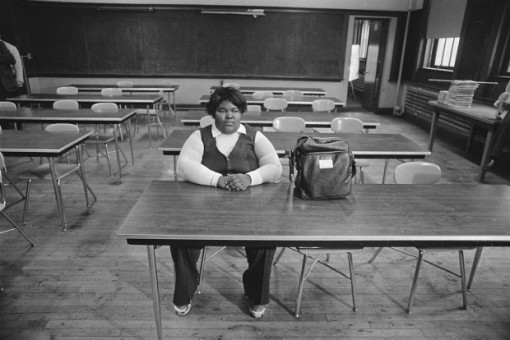We all know certain iconic photos from American history—a Migrant Mother staring down starvation during the Great Depression:
U.S. Marines and Navy soldiers raising the U.S. flag at Iwo Jima during WWII:
and this photo of a black American seemingly about to be stabbed with an American flag during a civil rights protest:
Each of these photos has been misinterpreted in some way. In this short series, we’ll start with the last one. It was taken by Stanley Forman on April 5, 1976, in Boston, Massachusetts during a protest over court-ordered school desegregation—busing. It seems to show a white man about to stab a black man who is helplessly pinned and prevented from escaping by another white man. The attacker is Joseph Rakes, the black victim Ted Landsmark, the man pinning him back is Jim Kelly.
What they were really doing is this: Rakes, holding the flag, was swinging it at Landsmark in an attempt to threaten him, but was not running toward him to kill. You can see that Rakes’ feet are planted—he’s not moving. He was just at a point in his flag-swinging where the flag was horizontal. Rakes was against busing, but he was not trying to kill anyone.
The man holding Landsmark, Jim Kelly, was a Boston city councillor who was notoriously against desegregation of any kind—in schools, housing, anywhere. He was there to protest busing. Yet it is Kelly who is trying to get Landsmark out of the way of this man waving the flag because he was afraid Landsmark would be attacked. You can see that Kelly’s feet are moving. Ted Landsmark was a lawyer—you can see he is the only one wearing a suit—who had already been attacked by anti-busing rioters and had his nose broken. He seems to be resisting Kelly, perhaps thinking he is yet another white about to attack him.
Rakes later said that he first saw this photo on the bus as he rode to work the next day. It was on the cover of the newspaper someone else was reading. “I saw the image and thought, ‘Who is that lunatic with the flag?’ Then I realized it was me.”
Even if Rakes wasn’t about to stab Landsmark with the flag, it’s a chilling image. Using the flag as a threat in any way is a cruel and sickening perversion of that national symbol. You don’t have to stab someone with it to soil Old Glory; just using it to protest democracy is soiling enough.
But taking the time to learn the truth about this image is more instructive than just being repulsed by what it seems to show. That Jim Kelly would protect a black man who was promoting busing tells an uplifting story about humanity and decency trumping racism, even if for a moment. And Rakes’ immediate reaction to the photo, in which he saw a “lunatic”, also cuts through the ideology of racism and reveals the basic indecency of any racial attack.
For each photo that we deconstruct here, we’ll offer one that is not so famous but should be. Here is the first:
On September 12, 1974, when the school year began in Boston with court-ordered busing despite the protests, white students at South Boston High School boycotted classes. Some refused to sit with black students. Others were afraid of the inevitable violence that would take place in and around the school. Black students also boycotted, for fear of being attacked. Only this young woman, Valerie Banks, bravely showed up to her geography class that day. This lone American, waiting with determination, patience, and courage for a better day, should be remembered.



